
|   |

|   |
The Rajarani Temple reverberates with the thrill of classical music Photos courtesy: Odisha Tourism January 23, 2012 With spring setting in, the famous 11th century Rajarani Temple vibrated with the symphony of enchanting Indian classical music presented by eminent artistes of national and international repute. On behalf of Department of Tourism & Culture, Government of Odisha, the Odisha Sangeet Natak Akademi organised this festival of classical music from 18th to 20th January 2012 on the lush green ambience in the precinct of the magnificent Rajarani Temple. Today the most important task we envisage is the preservation of our traditional music cultures. Apart from documentation and recordings, this needs systematic, comprehensive and meaningful programs to present ancient tradition with sophistication and refinement so as to cater to the taste of the connoisseurs and to meet the needs of the time, while keeping its pristine glory intact. Perhaps this is the way not only to preserve our performing arts but to facilitate healthy growth and development to keep the vital links of our tradition alive. 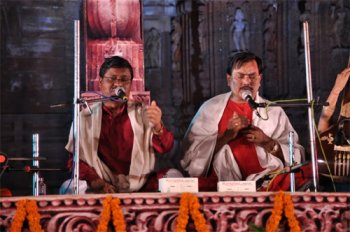 Ramhari Das and Bijaya Kumar Jena 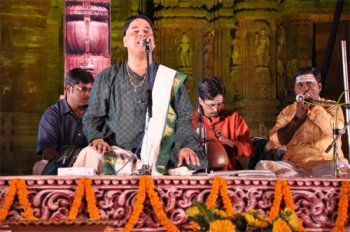 OS Arun The festival commenced on Jan 18 with an Odissi vocal recital by renowned music composer and Odissi Research Centre chief Ramhari Das and head of Utkal Sangeet Mahavidyalaya, Bijaya Kumar Jena. The recital started with Raganga phase, a song “Mahimandana Tu Namara Marare” written by Surya Baladev Rath set to raag Margavihara and tala ektali. This was followed by Bhabanga “Aaua Kaha Kara Dharibi” written by Upendra Bhanja set to raag Mukhari and tala jati. In Dhruba Padanga phase, the duo presented a traditional composition “Prana Sajani Kehi Banchiba Jamini” set to raag Kedara Kamodi and tala tripata. This traditional prabandha was marked by elegantly rendered anibadha alapa and swara bistara. This was followed by Pallavi set to raag Khamaj and tal khemta. The next presentation was Chhanda, an important stream of Odissi music in which the duo presented “Äare Babu Samaghana Tu Gale Madhubana” written by Kavi Gopal Krushna based on Vatsalya rasa. The conluding item was Janana, a devotional rendering typical of Odissi music, “Dinabandhu Daitari” written by Kavi Banamali. The Odissi songs presented by Ramhari Das and Bijaya Kumar Jena were marked with remarkable euphony and variegated graceful embellishment punctuated by indigenous rhythmic patterns. The music lovers present were deeply engrossed in the superb and impeccable elaboration of different ragas and musical patterns, clear tonal quality and musical rendering. The evening’s second artiste was OS Arun, a versatile Carnatic musician and composer who in his mellifluous and sonorous voice started with Ganapati Vandana written by Muthuswami Dikshitar followed by two songs set to raag Hamsadhwani and adi tala and Rageshree set to adi tala. The delineation of the ragas giving full vent to his imagination based on the musical notes with an eclectic and comprehensive description by OS Arun regaled the audience. The dignitaries who graced the inaugural function were eminent flautist Hari Prasad Chaurasia, noted singer Prafulla Kar, US Ambassador to India Mr. Peter Balley, Aruna Mohanty, Vice President, OSNA, Ashok Kumar Tripathy, Principal Secretary, Tourism & Culture Department, HS Upadhyay, Director, Tourism and Sunil Kumar Das, Director, Culture. 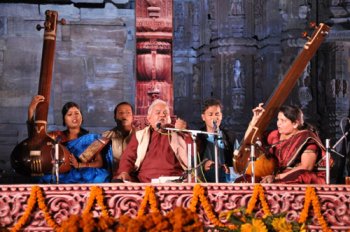 Dr. Damodar Hota 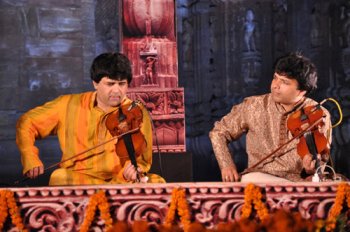 Ganesh & Kumaresh On the second day of the Rajarani Music Festival, the weather was pleasant and the verdant premises of the temple bedecked with colourful lights and applique works provided an enchanting setting. The evening’s first program was an Odissi vocal recital by the great singer, scholar and versatile artiste Pt Dr. Damodar Hota who has been consistently endeavouring to promote Odissi music with its intricate singing style (Gayaki) under the nomenclature of Üdra Padhatiya Sangita. He commenced with “Dekha Shree Jagannathanku,” then Chaturanga Odissi (Vira Vesa Go) followed by Tribhanga (Tajham Ta Ta Jhum) set to raag Kokila tala adatali. Dr. Hota then presented Siva Vandana (Bam Bam Hara Hara) set to raag Natakalyani tala ekatali and Odissi song “Dekhiba Para Aasare” set to raag Kalyani tala sariman. In the third and last phase of his Odissi recital, Pt Hota sang “Prana Sangini Re Kali Mu Ki Laje Sadhili” written by Kavi Banamali set to raag Abherika and tala adatali. He was accompained on mardala by Jayadev Giri, on harmonium by Prasanta Kumar Rath, on violin by Baidhara Rout and on tanpura and vocal support by Kalpana Padhy, Pranati Behera and Guru Krushna Chandra Das. The presentation by Dr. Hota was marked by flawless elaboration of ragas, creativity and embellishment of the ideation and beautiful melody and perfect layakaris. This was followed by a concert featuring Carnatic violin maestros Ganesh and Kumaresh who presented raag Mayamalavagaula followed by fusion music showcasing the intricacies of Carnatic music, the weaving of svara patterns in different tempos, rhythms and gaits in the given tala, developed variations creating aesthetics in melodic theme developed from simplicity to complexity, increasing embellishment and dynamics. The decorative elements were judiciously applied so as to enhance the beauty of the compositions. The duo who enthralled the audience were accompained on mridangam by R Ramesh and on ghatam by Trichy Krishna. 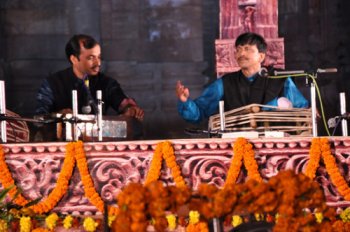 Brunda Mardala Badana by Guru Dhaneswar Swain and disciples 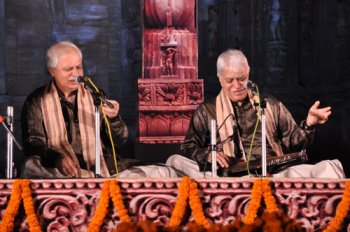 Rajan & Sajan Mishra The concluding evening at the Rajarani temple witnessed scintillating performance on Odissi percussion instruments led by eminent mardala player Guru Dhaneswar Swain and Hindustani vocal by internationally acclaimed duo, brothers Rajan and Sajan Mishra, who say while singing they have two bodies but one soul. The first program was Brunda Mardala Badana by Guru Dhaneswar Swain and his disciples who played adi tala of 16 beats producing different layakaris punctuated with bols or ukutas with special use of traditional musical phases like khandi, gadi, arasa, mana, bhaunri mana, chhaka mana, jamana with different layakaris and chaturgati ragada and chhanda prakarana which produce special striking structure typical to Odissi music. Guru Swain then presented tritaal of 16 beats punctuated with typical musical renderings using uthana, elaboration of dharana, jati, chakradar, biram, abiram, lagana mana, bira mana, kaida, sabdaswarpata, rela etc having different layas and chhandas. This unique ensemble of indigenous musical instruments was well orchestrated with mardal, tabla, tikira, khanjani, khol, nal, jhanja, ghungura, manjira, dhol and jhumka, etc. He used traditional rhythm patterns to create a unique rhythm which started with a melody and culminated with a crescendo. The rhythm and the beats perfectly synchronized with the bols (rhythmic syllables) in conformity with different notations and produced a melody that delighted the music lovers. Guru Dhaneswar Swain was assisted by Rankanidhi Pradhan on tabla, Ajay Choudhury on khanjani, Baibhaba Kumar on dholak, Kalindi Charan Parida on khol, Budhanath Swain on mardala, Rajendra Swain and Surendra Tripathy on harmonium, Sanjeev Kundu on violin, Rabi Naryan Barik on jodi nagara, Biswaranjan Nanda on tabla, Soubhagya Naryan Chhotray, Bibhuti Bhusan Beura and Pratap Mishra on mardala apart from rendering melodious bols. The second programme was a bandish “Kabana Gatvai Mori Piya Na Puchhe Ekaibar” set to raag Bageshree, tala bilambita ektali followed by two bhajans, “Sadha Raseo” and “Ab Krupa Karo Ram Nam Se Dukh Talo.” Their recital was marked with step-by-step elaboration in Bilambita and Drutalaya giving scope for vocal embellishments, simpler and softer movement from one note to other. While executing intricate tans and sargams, their wide ranging voice, combined with masterly command over technique, translated their flight of imagination into sublime music. They were accompanied on tabla by Pt Sohanlal Mishra, on harmonium by Sumit Mishra and on tanpura by Santosh Kumar Panda. 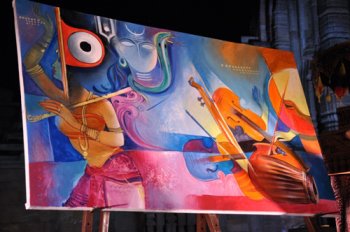 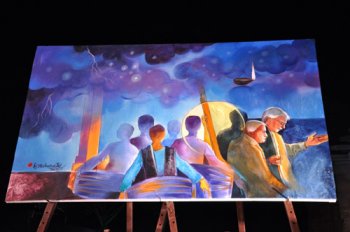
paintings by Baladev Maharatha
On all three evenings, the musical recitations were thematically and
beautifully captured on canvas by artist Baladev Maharatha. The comperes
were Shrinivas Ghatuari and Adyasha Mohapatra. |